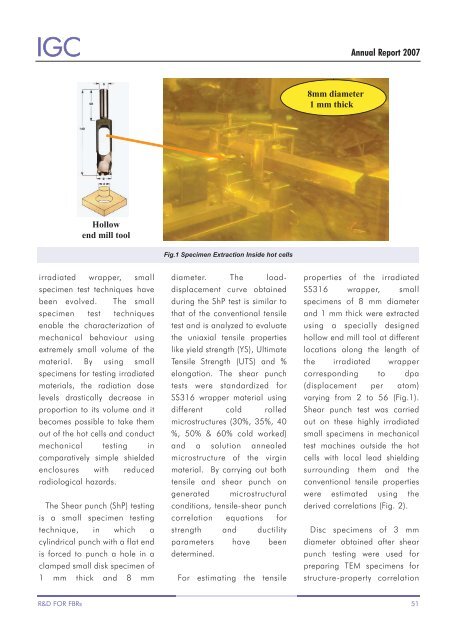IGCAR : Annual Report - Indira Gandhi Centre for Atomic Research
IGCAR : Annual Report - Indira Gandhi Centre for Atomic Research
IGCAR : Annual Report - Indira Gandhi Centre for Atomic Research
Create successful ePaper yourself
Turn your PDF publications into a flip-book with our unique Google optimized e-Paper software.
IGC<br />
<strong>Annual</strong> <strong>Report</strong> 2007<br />
8mm diameter<br />
1 mm thick<br />
Hollow<br />
end mill tool<br />
Fig.1 Specimen Extraction Inside hot cells<br />
irradiated wrapper, small<br />
specimen test techniques have<br />
been evolved. The small<br />
specimen test techniques<br />
enable the characterization of<br />
mechanical behaviour using<br />
extremely small volume of the<br />
material. By using small<br />
specimens <strong>for</strong> testing irradiated<br />
materials, the radiation dose<br />
levels drastically decrease in<br />
proportion to its volume and it<br />
becomes possible to take them<br />
out of the hot cells and conduct<br />
mechanical testing in<br />
comparatively simple shielded<br />
enclosures with reduced<br />
radiological hazards.<br />
The Shear punch (ShP) testing<br />
is a small specimen testing<br />
technique, in which a<br />
cylindrical punch with a flat end<br />
is <strong>for</strong>ced to punch a hole in a<br />
clamped small disk specimen of<br />
1 mm thick and 8 mm<br />
diameter. The loaddisplacement<br />
curve obtained<br />
during the ShP test is similar to<br />
that of the conventional tensile<br />
test and is analyzed to evaluate<br />
the uniaxial tensile properties<br />
like yield strength (YS), Ultimate<br />
Tensile Strength (UTS) and %<br />
elongation. The shear punch<br />
tests were standardized <strong>for</strong><br />
SS316 wrapper material using<br />
different cold rolled<br />
microstructures (30%, 35%, 40<br />
%, 50% & 60% cold worked)<br />
and a solution annealed<br />
microstructure of the virgin<br />
material. By carrying out both<br />
tensile and shear punch on<br />
generated microstructural<br />
conditions, tensile-shear punch<br />
correlation equations <strong>for</strong><br />
strength and ductility<br />
parameters have been<br />
determined.<br />
For estimating the tensile<br />
properties of the irradiated<br />
SS316 wrapper, small<br />
specimens of 8 mm diameter<br />
and 1 mm thick were extracted<br />
using a specially designed<br />
hollow end mill tool at different<br />
locations along the length of<br />
the irradiated wrapper<br />
corresponding to dpa<br />
(displacement per atom)<br />
varying from 2 to 56 (Fig.1).<br />
Shear punch test was carried<br />
out on these highly irradiated<br />
small specimens in mechanical<br />
test machines outside the hot<br />
cells with local lead shielding<br />
surrounding them and the<br />
conventional tensile properties<br />
were estimated using the<br />
derived correlations (Fig. 2).<br />
Disc specimens of 3 mm<br />
diameter obtained after shear<br />
punch testing were used <strong>for</strong><br />
preparing TEM specimens <strong>for</strong><br />
structure-property correlation<br />
R&D FOR FBRs 51

















